| SHENZHOU-1/2/3/4 UNMANNED SPACEFLIGHT MISSION
中国“神舟”-1/2/3/4无人操纵航天飞行任务 Date:2016-01-08 Source:internet By:Globalmil Viewed: |
Between November 1999 and December 2002, China launched four unmanned experimental spaceships to test the launch vehicle, spaceship, and life support systems onboard. The four unmanned missions, designated ShenZhou-1 to 4, provide some valuable experience that enables the designers to improve and finalise their designs before the first manned mission can be carried out.
在1999年11月和2002年12月之间,中国发射四艘无人实验太空船去测试运载火箭、太空船和生命支援系统。四次无人操纵任务,命名为“神舟”(ShenZhou)-1到4,在第一次有人操纵任务能被实行之前,提供使设计者能够改良和完成他们的设计一些有价值的经验。
SHENZHOU-1
“神舟” -1
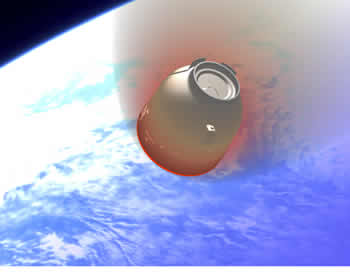
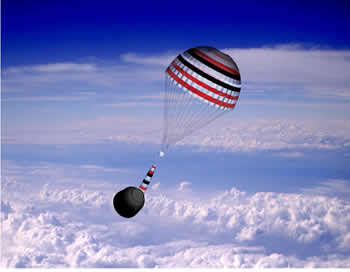
On 20 November 1999, China announced that it has successfully launched the first ShenZhou spaceship. An electronic experimental prototype with no life support or emergency escaping system, ShenZhou (also referred to as ShenZhou-1) carried no mission payload onboard. The mission was simply to test the spaceship itself. This was also the first launch of the ChangZheng-2F launch vehicle, which was specifically designed for the manned spaceflight programme.
在1999年11月20日,中国已经成功地发射第一艘“神舟”太空船。有一个电子实验样机但没有生命保障或紧急状况逃脱系统,“神舟”(也提到到被称为“神舟”-1)在飞船上没有携带任务负载。任务只是要测试太空船它本身。这也是长征(ChangZheng)-2 F运载火箭 第一次发射,被明确地设计用于有人操纵宇宙飞行计划。
Launched from Jiuquan Satellite Launch Centre (JSLC) by a CZ-2F space launch vehicle at local time 06:30 on 20 November (22:30 GMT 19 November), the spaceship entered into orbit about 10 minutes after the lift-off. The ShenZhou spaceship flew 21 hours 11 minutes (14 orbits) before the YuanWang-3 tracking ship off the coast of Namibia picked up the spacecraft's signal at 18:49 GMT, and commanded retro-fire.
在1999年11月20日当地时间06:30(格林威治标准时间11月19日22:30)从酒泉卫星发射中心(JSLC)被一枚CZ-2 F运载火箭发射,太空船在离地升空之后大约10 分钟进入轨道。在格林威治标准时间18:49“远望”(YuanWang)-3遥测船离开那米比亚海岸采集太空船的信号,而且命令返回点火,“神舟”太空船飞行了21个小时11分钟(环绕轨道14圈)。
The re-entry capsule of the spaceship entered the earth atmosphere and flew over the coast of the Arabian peninsula, and then over Pakistan, and entered Chinese territory over Tibet. The drogue chute deployed at an altitude of 30km and the re-entry capsule soft-landed in the scheduled landing spot in Inner Mongolia. The capsule touched down at 03:41 Beijing Time on 21 November 1999 (19:41 GMT on 20 November 1999).
太空船再返回太空舱进入了地球大气层而且飞过阿拉伯半岛海岸,然后越过巴基斯坦上空,而且进入中国领土越过了西藏。在30公里高空锥形降落伞展开和再返回太空舱在内蒙古预定的登陆点中着陆。太空舱在1999年11月21日北京时间03:41(格林威治标准时间1999年11月20日19:41)降下。
The ShenZhou-1 mission marked an important milestone in the Project 921, the Chinese manned space programme. The mission formed the first basis on which subsequent missions were carried out, eventually leading to the first successful manned mission.
“神舟”-1任务在中国有人操纵空间计划-921计划中标明一个重要的里程碑。这次任务形成了进行随后的任务的第一个基础,最后主导到第一次成功的有人操纵任务之上。
SHENZHOU-2
“神舟” -2
ShenZhou-2 unmanned spaceship was launched 9 January 2001 at 09:00 Beijing Time (01:00 GMT). Apart from serving as the prototype for the future manned spaceflight, the spaceship also carried sophisticated space science laboratory, with a total of 64 science experiment payloads, including 15 in the re-entry module, 12 in the orbital module and 37 on the forward external pallet. These included a micro-gravity crystal growing device, life sciences experiments with 19 species of animals and plants, cosmic ray and particle detectors; and China's first gamma ray burst detectors.
“神舟”-2无人操纵太空船在2001年1月9日北京时间09:00(格林威治标准时间01:00)发射,服务的一部分被当做将来的有人操纵航天原型,太空船也携带了复杂的空间科学实验室,总数为64个科学实验负载量,包括15个在再返回模组中,12个在轨道模组中和37个在前部的外面托板上。这些包括了一个微-重力晶体成长装置,生命科学实验和19种动植物;宇宙射线粒子探测器;中国的第一台伽玛射线爆炸检测器。
ShenZhou-2 made three orbit-raising manoeuvres during its flight, reaching a 330 x 345km orbit by the end of the initial phase of the mission. After orbiting around the earth 117 times, the descent and service modules were separated from the forward orbital module and external pallet. After retrofire by the service module, the re-entry capsule separated from the service module and landed on the grasslands in Inner Mongolia at 19:22 Beijing Time (11:22 GMT) on 16 January 2001.
“神舟”-2在它的飞行期间安排了三次升起轨道的调整,到达330x345公里轨道任务初始阶段结束。在地球轨道运行117圈之后,降落和服务模块与前部的轨道模块和外面的托板分离。在返回发射之后使用服务模块,再返回太空舱从服务模块分开,北京时间2001年1月16日19:22(格林威治标准时间11:22)在内蒙古草原上降落。
Lack of publicity photographs of the recovered re-entry capsule led to speculation that the re-entry capsule may have been destroyed during the re-entry, but this cannot be confirmed.
缺乏再返回太空舱公开图片,导致推测再返回太空舱可能已经在再返回期间被破坏,但是这不能够是确认的。
SHENZHOU-3
“神舟” -3
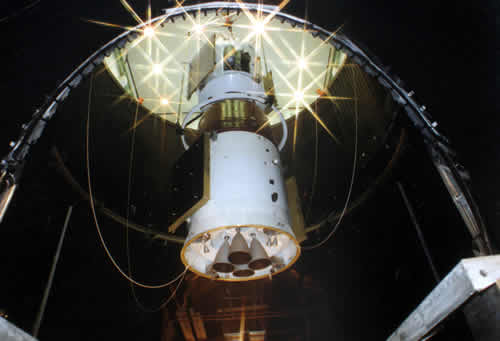
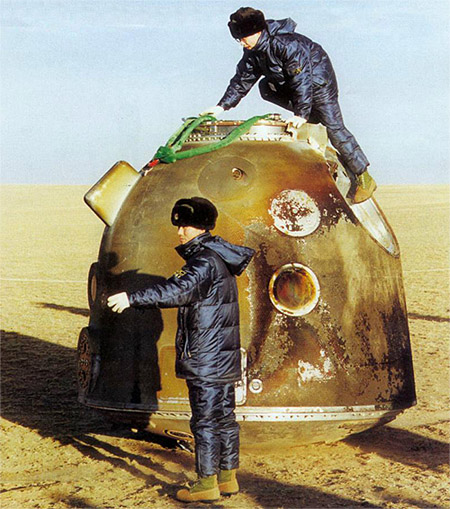
地面人员工作在“神舟”-3返回的太空舱上。这是被装备完全生命支援系统和紧急状况逃脱系统的第一艘太空船。它也携带了一个虚拟宇航员测试系统。
Ground crew working on the returned capsule of ShenZhou-3. This is the first spaceship to be equipped with full life support and emergency escaping system. It also carried a dummy astronaut to test the systems on board.
ShenZhou-3 unmanned spaceship was launched on 25 March 2002 at 22:00 Beijing Time (14:00 GMT). For the first time ShenZhou-3 spaceship is fully equipped with all that would be need for a manned flight, including the life support and emergency escape system. The spaceship also carried a dummy astronaut to test the reliability of life support system in space environment.
“神舟”-3无人操纵太空船在北京时间2002年3月25日22:00(格林威治标准时间14:00)发射。“神舟”-3太空船是第一次装备有人操纵的飞行全部需要,包括生命支援和紧急状况逃亡系统。太空船也携带了一个虚拟宇航员测试空间环境生命支援系统的可靠性。
After staying in the earth orbit for 6 days 18 hours 51 minutes, the re-entry capsule of the ShenZhou-3 returned to earth in central Inner Mongolia at 16:51 Beijing Time (08:51 GMT) on 1 April 2002. The orbit module remained in orbit until 12 November 2002.
在地球轨道中停留6天18小时51分钟之后,“神舟”-3的太空舱在北京时间2002年4月1日16:51(格林威治标准时间08:51)在内蒙古返回到地球。轨道模块在轨道中运行保持直到2002年11月12日。
SEHNZHOU-4
“神舟”-4
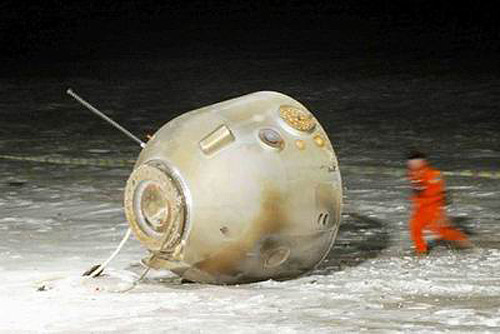
回收人员跑向前面降落在内蒙古太空船登陆位置的“神舟”-4再返回太空舱。这是最后一次无人实验任务,在921计划之下已经被实行。
Recovery crews running towards the re-entry capsule of ShenZhou-4 which landed at the spaceship landing site in Inner Mongolia. This was the last unmanned experimental mission that has been carried out under Project 921.
ShenZhou-4 is the fourth, and also the last unmanned experimental spaceship launched before the manned mission. The spaceship was launched on 30 December 2002 (16:40 GMT on 29 December).
“神舟”-4是第四次以及最后一次在有人操纵任务之前被发射的无人实验太空船。太空船在2002年12月30日(格林威治标准时间12月29日16:40)发射。
ShenZhou-4 carried a retrievable crew module with all furnishings, test equipment, and two dummy astronaut to assess its viability for a manned launch. Additionally the spaceship also carried 52 science payloads for earth observation, space environment monitoring, micro-gravity fluid physics, and biological technology research. After staying on the earth orbit for 7 days, the re-entry capsule of ShenZhou-4 was successfully recovered on 5 January 2003 at 19:16 Beijing Time (11:16 GMT), with the orbit module remaining on earth orbit for another six months.
“神舟”-4携带一个可收回乘员模块,具有所有的陈设、测试设备和二名虚拟宇航员,为有人操纵发射估定它的生存能力。附加地太空船也用于地球观测、空间环境监听 、微-重力流体物理学和生物学技术研究,携带了52个科学负载量。在地球轨道上停留7天以后,“神舟”-4 的再返回太空舱在北京时间2003年1月5日19:16(格林威治标准时间11:16)被成功地找回,在地球轨道上剩余的轨道组件另外运行了六个月之久。
The whole mission was said to be a total success, which made programme leaders determined to launch the first manned spaceship in the next mission.
整个任务据说是全部成功,使计划领导层决定发射下一个任务,第一次有人操纵太空船。
上一篇:PROJECT 921-III (SPACE STATION) 下一篇:CHANG'E MOON EXPLORATION PROGRAMME
| TianGong 1 Spaceflight Mission
中国天宫(TianGong) 1航天任务 |
| As the first step, China will launch TianGong 1, also known as “target spacecraft”... [2020-12-08] |
| CHANG'E MOON EXPLORATION PROGRAMME
中国航天月球探险计划 |
| The Chinese government first announced that it was planning to carry out moon exploration and preliminary deep space research in its White Paper on China’s Space Activities published on 11 November 2000.... [2016-01-08] |
| SHENZHOU-1/2/3/4 UNMANNED SPACEFLIGHT MISSION
中国“神舟”-1/2/3/4无人操纵航天飞行任务 |
| Between November 1999 and December 2002, China launched four unmanned experimental spaceships to test the launch vehicle, spaceship, and life support systems onboard.... [2016-01-08] |
| PROJECT 921-III (SPACE STATION)
中国航天921-III计划(空间站) |
| In the third stage of the Chinese manned spaceflight programme, which is known as Project 921-III, China is going to build a permanent space station where astronauts can live for a long period (few months) and conduct various scientific expe... [2016-01-08] |
